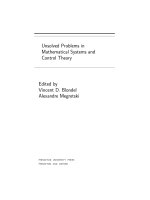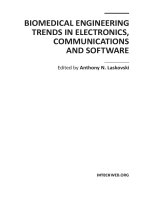Trends in Intelligent Systems and Computer Engineering
Bạn đang xem bản rút gọn của tài liệu. Xem và tải ngay bản đầy đủ của tài liệu tại đây (13.59 MB, 666 trang )
and Computer Engineering
Trends in Intelligent Systems
Volume 6
Oscar Castillo, Li Xu, and Sio-Iong Ao
Recent Advances in Industrial Engineering and Operations Research
ISBN 978-0-387-74934-1, 2008
Alan H. S. Chan, and Sio-Iong Ao
Lecture Notes in Electrical Engineering
ISBN 978-0-387-74903-7, 2008
Advances in Communication Systems and Electrical Engineering
ISBN 978-0-387-74937-2, 2008
Xu Huang, Yuh-Shyan Chen, and Sio-Iong Ao
Time-Domain Beamforming and Blind Source Separation
Julien Bourgeois, and Wolfgang Minker
Digital Noise Monitoring of Defect Origin
Telman Aliev
ISBN 978-0-387-71753-1, 2007
ISBN 978-0-387-68835-0, 2007
Multi-Carrier Spread Spectrum 2007
Simon Plass, Armin Dammann, Stefan Kaiser, and K. Fazel
ISBN 978-1-4020-6128-8, 2007
Trends in Intelligent Systems and Computer Engineering
123
Oscar Castillo • Li Xu • Sio-Iong Ao
Systems
and Computer
Engineering
Editors
Trends in Intelligent
Sio-Iong Ao
IAENG Secretariat
Unit 1, 1/F
Hong Kong
People s Republic of China
2008 Springer Science+Business Media, LLC
or dissimilar methodology now known or hereafter developed is forbidden.
to proprietary rights.
9 8 7 6 5 4 3 2 1
springer.com
Oscar Castillo
Tijuana Institute of Technology
Department of Computer Science
Chula Vista CA 91909
USA
Li Xu
Zhejiang University
College of Electrical Engineering
Department of Systems Science
Yu-Quan Campus
310027 Hangzhou
People
,
s Republic of China
,
ISBN: 978-0-387-74934-1 e-ISBN: 978-0-387-74935-8
DOI: 10.1007/978-0-387-74935-8
©
P.O. Box 4207
37-39 Hung To Road
Library of Congress Control Number: 2007935315
Printed on acid-free paper
All rights reserved. This work may not be translated or copied in whole or in part without the written
permission of the publisher (Springer Science+Business Media, LLC, 233 Spring Street, New York, NY
10013, USA),except for brief excerpts in connection with reviews or scholarly analysis. Use in connection
with any form of information storage and retrieval, electronic adaptation, computer software, or by similar
The use in this publication of trade names, trademarks, service marks, and similar terms, even if they are
not identified as such, is not to be taken as an expression of opinion as to whether or not they are subject
Editors
and Engineering
Preface
A large international conference, Intelligent Systems and Computer Engineering,
was held in Hong Kong, March 21–23, 2007, under the International MultiConfer-
ence of Engineers and Computer Scientists (IMECS) 2007. The IMECS 2007 is
organized by the International Association of Engineers (IAENG), a nonprofit inter-
national association for engineers and computer scientists. The IMECS conferences
serve as good platforms for the engineering community to meet with each other and
to exchange ideas. The conferences also strike a balance between theoretical and ap-
plication development. The conference committees have been formed with over two
hundred committee members who are mainly research center heads, faculty deans,
department heads, professors, and research scientists from over thirty countries. The
conferences are truly international meetings with a high level of participation from
many countries. The response that we have received for the multiconference is ex-
cellent. There have been more than one thousand one hundred manuscript submis-
sions for the IMECS 2007. All submitted papers have gone through the peer review
process and the overall acceptance rate is 58.46%.
This volume contains revised and extended research articles on intelligent sys-
tems and computer engineering written by prominent researchers participating in
the multiconference IMECS 2007. There is huge demand, not only for theories but
also applications, for the intelligent systems and computer engineering in the society
to meet the needs of rapidly developing top-end high technologies and to improve
the increasing high quality of life. Topics covered include automated planning, ex-
pert systems, machine learning, fuzzy systems, knowledge-based systems, computer
systems organization, computing methodologies, and industrial applications. The
papers are representative of these subjects. The book offers state-of-the-art tremen-
dous advances in intelligent systems and computer engineering and also serves as
an excellent reference work for researchers and graduate students working with in-
telligent systems and computer engineering.
Sio Iong Ao, Oscar Castillo, and Li Xu
July 2007
Hong Kong, Mexico, and China
v
Contents
Preface v
Contributors xi
1 A Metamodel-Assisted Steady-State Evolution Strategy
for Simulation-Based Optimization 1
Anna Persson, Henrik Grimm, and Amos Ng
2 Automatically Defined Groups for Knowledge Acquisition
from Computer Logs and Its Extension for Adaptive Agent Size 15
Akira Hara, Yoshiaki Kurosawa, and Takumi Ichimura
3 Robust Hybrid Sliding Mode Control for Uncertain Nonlinear
Systems Using Output Recurrent CMAC 33
Chih-Min Lin, Ming-Hung Lin, and Chiu-Hsiung Chen
4 A Dynamic GA-Based Rhythm Generator 57
Tzimeas Dimitrios and Mangina Eleni
5 Evolutionary Particle Swarm Optimization: A Metaoptimization
Method with GA for Estimating Optimal PSO Models 75
Hong Zhang and Masumi Ishikawa
6 Human–Robot Interaction as a Cooperative Game 91
Kang Woo Lee and Jeong-Hoon Hwang
7 Swarm and Entropic Modeling for Landmine Detection Robots 105
Cagdas Bayram, Hakki Erhan Sevil, and Serhan Ozdemir
8 Iris Recognition Based on 2D Wavelet and AdaBoost Neural
Network 117
Anna Wang, Yu Chen, Xinhua Zhang, and Jie Wu
vii
viii Contents
9 An Improved Multiclassifier for Soft Fault Diagnosis of Analog
Circuits 129
Anna Wang and Junfang Liu
10 The Effect of Background Knowledge in Graph-Based Learning
in the Chemoinformatics Domain 141
Thashmee Karunaratne and Henrik Bostr
¨
om
11 Clustering Dependencies with Support Vectors 155
I. Zoppis and G. Mauri
12 A Comparative Study of Gender Assignment in a Standard Genetic
Algorithm 167
K. Tahera, R. N. Ibrahim, and P. B. Lochert
13 PSO Algorithm for Primer Design 175
Ming-Hsien Lin, Yu-Huei Cheng, Cheng-San Yang, Hsueh-Wei Chang,
Li-Yeh Chuang, and Cheng-Hong Yang
14 Genetic Algorithms and Heuristic Rules for Solving the Nesting
Problem in the Package Industry 189
Roberto Selow, Fl
´
avio Neves, Jr., and Heitor S. Lopes
15 MCSA-CNN Algorithm for Image Noise Cancellation 209
Te-Jen Su, Yi-Hui, Chiao-Yu Chuang, and Wen-Pin Tsai
16 An Integrated Approach Providing Exact SNP IDs from Sequences . 221
Yu-Huei Cheng, Cheng-San Yang, Hsueh-Wei Chang, Li-Yeh Chuang,
and Cheng-Hong Yang
17 Pseudo-Reverse Approach in Genetic Evolution 233
Sukanya Manna and Cheng-Yuan Liou
18 Microarray Data Feature Selection Using Hybrid GA-IBPSO 243
Cheng-San Yang, Li-Yeh Chuang, Chang-Hsuan Ho, and Cheng-Hong
Yang
19 Discrete-Time Model Representations for Biochemical Pathways 255
Fei He, Lam Fat Yeung, and Martin Brown
20 Performance Evaluation of Decision Tree for Intrusion Detection
Using Reduced Feature Spaces 273
Behrouz Minaei Bidgoli, Morteza Analoui, Mohammad Hossein
Rezvani, and Hadi Shahriar Shahhoseini
21 Novel and Efficient Hybrid Strategies for Constraining the Search
Space in Frequent Itemset Mining 285
B. Kalpana and R. Nadarajan
Contents ix
22 Detecting Similar Negotiation Strategies 297
Lena Mashayekhy, Mohammad A. Nematbakhsh, and Behrouz
T. Ladani
23 Neural Networks Applied to Medical Data for Prediction of Patient
Outcome 309
Machi Suka, Shinichi Oeda, Takumi Ichimura, Katsumi Yoshida, and
Jun Takezawa
24 Prediction Method for Real Thai Stock Index Based on Neurofuzzy
Approach 327
Monruthai Radeerom, Chonawat Srisa-an, and M.L. Kulthon Kasemsan
25 Innovative Technology Management System with Bibliometrics
in the Context of Technology Intelligence 349
Hua Chang, J
¨
urgen Gausemeier, Stephan Ihmels, and Christoph
Wenzelmann
26 Cobweb/IDX: Mapping Cobweb to SQL 363
Konstantina Lepinioti and Stephen Mc Kearney
27 Interoperability of Performance and Functional Analysis
for Electronic System Designs in Behavioural Hybrid Process
Calculus (BHPC) 375
Ka Lok Man and Michel P. Schellekens
28 Partitioning Strategy for Embedded Multiprocessor FPGA Systems . 395
Trong-Yen Lee, Yang-Hsin Fan, Yu-Min Cheng, Chia-Chun Tsai,
and Rong-Shue Hsiao
29 Interpretation of Sound Tomography Image for the Recognition
of Ganoderma Infection Level in Oil Palm 409
Mohd Su’ud Mazliham, Pierre Loonis, and Abu Seman Idris
30 A Secure Multiagent Intelligent Conceptual Framework
for Modeling Enterprise Resource Planning 427
Kaveh Pashaei, Farzad Peyravi, and Fattaneh Taghyareh
31 On Generating Algebraic Equations for A5-Type Key Stream
Generator 443
Mehreen Afzal and Ashraf Masood
32 A Simulation-Based Study on Memory Design Issues for Embedded
Systems 453
Mohsen Sharifi, Mohsen Soryani, and Mohammad Hossein Rezvani
33 SimDiv: A New Solution for Protein Comparison 467
Hassan Sayyadi, Sara Salehi, and Mohammad Ghodsi
x Contents
34 Using Filtering Algorithm for Partial Similarity Search on 3D
Shape Retrieval System 485
Yingliang Lu, Kunihiko Kaneko, and Akifumi Makinouchi
35 Topic-Specific Language Model Based on Graph Spectral Approach
for Speech Recognition 497
Shinya Takahashi
36 Automatic Construction of FSA Language Model for Speech
Recognition by FSA DP-Matching 515
Tsuyoshi Morimoto and Shin-ya Takahashi
37 Density: A Context Parameter of Ad Hoc Networks 525
Muhammad Hassan Raza, Larry Hughes, and Imran Raza
38 Integrating Design by Contract Focusing Maximum Benefit 541
J
¨
org Preißinger
39 Performance Engineering for Enterprise Applications 557
Marcel Seelig, Jan Schaffner, and Gero Decker
40 A Framework for UML-Based Software Component Testing 575
Weiqun Zheng and Gary Bundell
41 Extending the Service Domain of an Interactive Bounded Queue 599
Walter Dosch and Annette St
¨
umpel
42 A Hybrid Evolutionary Approach to Cluster Detection 619
Junping Sun, William Sverdlik, and Samir Tout
43 Transforming the Natural Language Text for Improving
Compression Performance 637
Ashutosh Gupta and Suneeta Agarwal
44 Compression Using Encryption 645
Ashutosh Gupta and Suneeta Agarwal
Index 655
Contributors
Mehreen Afzal
National University of Science and Technology, Pakistan,
Suneeta Agarwal
Computer Science & Engineering Department, Motilal Nehru National Institute of
Technology, Allahabad, India,
Morteza Analoui
Computer Engineering Department, Iran University of Science and Technology,
Narmak, Tehran 16846, Iran,
Behrouz Minaei Bidgoli
Department of Computer Science and Engineering, Michigan State University, East
Lansing, MI 48824, USA,
Henrik Bostr
¨
om
Sk
¨
ovde Cognition and Artificial Intelligence Lab, School of Humanities and Infor-
matics, University of Sk
¨
ovde, SE-541 28 Sk
¨
ovde, Sweden,
Martin Brown
School of Electronic and Electrical Engineering, The University of Manchester,
Manchester M60 1QD, UK,
Gary Bundell
Centre for Intelligent Information Processing Systems, School of Electrical,
Electronic and Computer Engineering, University of Western Australia, Crawley,
WA 6009, Australia,
B. Eng. Hua Chang
Heinz Nixdorf Institute, University of Paderborn, Fuerstenallee 11, 33102
Paderborn, Germany,
xi
xii Contributors
Hsueh-Wei Chang
Environmental Biology, Kaohsiung,
Chiu-Hsiung Chen
Department of Computer Sciences and Information Engineering, China
University of Technology, HuKou Township 303, Taiwan, Republic of China,
Ken Chen
School of Computer & Information Engineering, Hunan Agricultural University,
Changsha 410128, China,
Yu Chen
Institute of Electronic Information Engineering, College of Information Science and
Engineering, Northeastern University, Shenyang, China,
Yu-Huei Cheng
Kaohsiung University,
Yu-Min Cheng
Chroma Corporation, Taiwan, Republic of China,
Chiao-Yu Chuang
Department of Electronic Engineering, National Kaohsiung University of Applied
Sciences, Kaohsiung, Taiwan 807, Republic of China
Li-Yeh Chuang
University, Kaohsiung, Taiwan
Gero Decker
Hasso-Plattner-Institute for Software Systems Engineering, Prof Dr Helmert-Str.
2-3, 14482 Potsdam, Germany,
Tzimeas Dimitrios
Department of Computer Science and Informatics, University College of Dublin,
Dublin, Ireland
Walter Dosch
University of L
¨
ubeck, Institute of Software Technology and Programming
Languages, L
¨
ubeck, Germany,
Yang-Hsin Fan
Department of Electronic Engineering, Institute of Computer and Communication
Engineering, National Taipei University of Technology, Taipei, Taiwan, Republic
of China
Information System Section of Library, National Taitung University, Taitung,
Taiwan, Republic of China,
J
¨
urgen Gausemeier
Heinz Nixdorf Institute, University of Paderborn, Fuerstenallee 11, 33102
Paderborn, Germany,
Contributors xiii
Mohammad Ghodsi
Computer Engineering Department, Sharif University of Technology, Tehran, Iran
IPM School of Computer Science, Tehran, Iran,
Henrik Grimm
Centre for Intelligent Automation, University of Sk
¨
ovde, Sweden
Ashutosh Gupta
Computer Science & Engineering Department, Institute of Engineering and Rural
Technology, Allahabad, India,
Akira Hara
Graduate School of Information Sciences, Hiroshima City University, 3-4-1,
Ozuka-higashi, Asaminami-ku, Hiroshima 731-3194, Japan,
cu.ac.jp
Fei He
School of Electronic and Electrical Engineering, The University of Manchester,
Manchester M60 1QD, UK
Department of Electronic Engineering, City University of Hong Kong, Hong Kong,
Rong-Shue Hsiao
Department of Electronic Engineering, Institute of Computer and Communication
Engineering, National Taipei University of Technology, Taipei, Taiwan, Republic
of China,
Larry Hughes
Department of Electrical and Computer Engineering, Dalhousie University,
Halifax, Nova Scotia, Canada,
Yi-Hui
Department of Electronic Engineering, National Kaohsiung University of Applied
Sciences, Kaohsiung, Taiwan 807, Republic of China
Lin Ming-Hung
Department of Electrical Engineering, Yuan-Ze University 135, Far-East Rd.,
Chung-Li, Tao-Yuan, 320, Taiwan, Republic of China,
Jeong-Hoon Hwang
Human-Robot Interaction Research Center, Korea Advanced Institute of Science
and Technology, 373-1 Guseong-dong, Yuseong-gu, Daejeon 305-701, Korea
R. N. Ibrahim
Department of Mechanical Engineering, Monash University, Wellington Rd.,
Clayton 3800, Australia,
Takumi Ichimura
Graduate School of Information Sciences, Hiroshima City University,
3-4-1, Ozuka-higashi, Asaminami-ku, Hiroshima 731-3194, Japan,
xiv Contributors
Masumi Ishikawa
Kyushu Institute of Technology, 2-4 Hibikino, Wakamatsu, Kitakyushu 808-0196,
Japan,
Sun Junping
Graduate School of Computer and Information Sciences, Nova Southeastern
University, Fort Lauderdale, FL 33314, USA
B. Kalpana
Department of Computer Science, Avinashilingam University for Women,
Coimbatore, India
Kunihiko Kaneko
Graduate School of Information Science and Electrical Engineering, Kyushu
University, Fukuoka, Japan,
Thashmee Karunaratne
Department of Computer and Systems Sciences, Stockholm University/Royal
Institute of Technology, Forum 100, SE-164 40 Kista, Sweden,
M. L. Kulthon Kasemsan
Science Program in Information Technology (MSIT), Faculty of
Information Technology, Rangsit University, Pathumtani, Thailand 12000,
Yoshiaki Kurosawa
Graduate School of Information Sciences, Hiroshima City University,
3-4-1, Ozuka-higashi, Asaminami-ku, Hiroshima 731-3194, Japan,
Behrouz T. Ladani
The University of Isfahan, Iran
Kang-Woo Lee
School of Media, Soongsil University, Sangdo-dong 511, Dongjak-gu, Seoul
156-743, South Korea,
Trong-Yen Lee
Department of Electronic Engineering, Institute of Computer and Communication
Engineering, National Taipei University of Technology, Taipei, Taiwan, Republic
of China,
Konstantina Lepinioti
School of Design, Engineering and Computing, Bournemouth University, UK,
Chih-Min Lin
Department of Electrical Engineering, Yuan-Ze University 135, Far-East Rd.,
Chung-Li, Tao-Yuan, 320, Taiwan, Republic of China,
Ming-Hsien Lin
Kaohsiung University,
Contributors xv
Cheng-Yuan Liou
Department of Computer Science and Information Engineering, National Taiwan
University, Taipei, Taiwan, Republic of China
Junfang Liu
College of Information Science and Engineering, Northeastern University,
Shenyang 110004, China
P. B. Lochert
Mechanical Engineering, Monash University, Wellington Rd, Clayton 3800,
Australia,
Heitor S. Lopes
CPGEI, Universidade Tecnol
´
ogica Federal do Paran
´
a (UTFPR), Av. 7 de setembro,
3165 - Curitiba - Paran
´
a, Brazil,
Yingliang Lu
Graduate School of Information Science and Electrical Engineering, Kyushu
University, Fukuoka, Japan,
Ka Lok Man
Centre for Efficiency-Oriented Languages (CEOL), Department of Computer
Science, University College Cork (UCC), Cork, Ireland
Eleni Mangina
Department of Computer Science and Informatics, University College of Dublin,
Dublin, Ireland
Sukanya Manna
Department of Computer Science and Information Engineering, National Taiwan
University, Taipei, Taiwan, Republic of China
Akifumi Makinouchi
Department of Information and Network Engineering, Kurume Institute of
Technology, Fukuoka, Japan,
Lena Mashayekhy
The University of Isfahan, Iran
Ashraf Masood
National University of Science and Technology, Pakistan
Stephen McKearney
School of Design, Engineering and Computing, Bournemouth University, UK,
Tsuyoshi Morimoto
Electronics and Computer Science Department, Fukuoka University,
8-19-1 Nanakuma, Jonan-ku, Fukuoka 814-0180, Japan,
fukuoka-u-ac.jp
xvi Contributors
R. Nadarajan
Department of Mathematics and Computer Applications, PSG College of
Technology, Coimbatore, India
Mohammad A. Nematbakhsh
The University of Isfahan, Iran
Fl
´
avio Neves Junior
CPGEI, Universidade Tecnol
´
ogica Federal do Paran
´
a (UTFPR), Av. 7 de setembro,
3165 - Curitiba - Paran
´
a, Brazil,
Amos Ng
Centre for Intelligent Automation, University of Sk
¨
ovde, Sweden
Shinichi Oeda
Department of Information and Computer Engineering, Kisarazu National College
of Technology, Kisarazu, Japan
Serhan Ozdemir
Mechanical Engineering Department, Izmir Institute of Technology, Izmir 35430,
Turkey,
Kaveh Pashaei
Electrical and Computer Engineering Faculty, School of Engineering, University of
Tehran, Tehran, Iran,
Anna Person
Centre for Intelligent Automation, University of Sk
¨
ovde, Sweden
Farzad Peyravi
Electrical and Computer Engineering Faculty, School of Engineering, University of
Tehran, Tehran, Iran,
Loonis Pierre
Universite de La Rochelle, Laboratoire Informatique Image Interaction, Avenue
Michel Crepeau 17000 La Rochelle, France,
J
¨
org Preißinger
Institut f
¨
ur Informatik, Technische Universit
¨
at M
¨
unchen, Boltzmannstr. 385748
Garching bei M
¨
unchen, Germany,
Monruthai Radeerom
Science Program in Information Technology (MSIT), Faculty of Information
Technology, Rangsit University, Pathumtani, Thailand 12000, mradeerom@
yahoo.com
Imran Raza
Department of Computer Science, COMSATS Institute of Information Technology,
Lahore, Pakistan,
Contributors xvii
Muhammad Hassan Raza
Department of Engineering Mathematics and Internetworking, Dalhousie
University, Halifax, Nova Scotia, Canada,
Mohammad Hossein Rezvani
Computer Engineering Department, Iran University of Science and Technology,
Narmak, Tehran 16846, Iran,
Sara Salehi
Computer Engineering Department, Azad University, Tehran-South Branch, Iran,
Tout Samir
Department of Computer Science, Eastern Michigan University, Ypsilanti,
MI 48197, USA
Hassan Sayyadi
Computer Engineering Department, Sharif University of Technology, Tehran, Iran,
Michel P. Schellekens
Centre for Efficiency-Oriented Languages (CEOL), Department of Computer
Science, University College Cork (UCC), Cork, Ireland,
Marcel Seelig
Hasso-Plattner-Institute for Software Systems Engineering, Prof Dr Helmert-Str.
2-3, 14482 Potsdam, Germany,
Roberto Selow
Electrical Engineering Department, Centro Universit
´
ario Positivo,
Rua Prof. Pedro Viriato Parigot de Souza, 5300 - Curitiba - Paran
´
a, Brazil,
Idris Abu Seman
Malaysia Palm Oil Board No. 6, Persiaran Institusi, Bandar Baru Bangi, 43000
Kajang, Malaysia,
Hakki Erhan Sevil
Mechanical Engineering Department, Izmir Institute of Technology, Turkey,
Hadi Shahriar Shahhoseini
Electrical Engineering Department, Iran University of Science and Technology,
Narmak, Tehran 16844, Iran,
Mohsen Sharifi
Iran University of Science and Technology, Computer Engineering Department,
Tehran 16846-13114, Iran, msharifi@iust.ac.ir
xviii Contributors
Yue Shen
School of Computer & Information Engineering, Hunan Agricultural University,
Changsha 410128, China,
Mohsen Soryani
Iran University of Science and Technology, Computer Engineering Department,
Tehran 16846-13114, Iran,
Chonawat Srisa-an
Science Program in Information Technology (MSIT), Faculty of
Information Technology, Rangsit University, Pathumtani, Thailand 12000,
Annette St
¨
umpel
University of L
¨
ubeck, Institute of Software Technology and Programming
Languages, L
¨
ubeck, Germany
Te-Jen Su
Department of Electronic Engineering, National Kaohsiung University of Applied
Sciences, Kaohsiung, Taiwan 807, Republic of China,
Machi Suka
Department of Preventive Medicine, St. Marianna University School of Medicine,
Kawasaki, Japan
Mazliham Mohd Su’ud
Universiti Kuala Lumpur, Sek 14, Jalan Teras Jernang 43650 Bandar Baru Bangi,
Selangor, Malaysia,
Universite de La Rochelle, Laboratoire Informatique Image Interaction, Avenue
Michel Crepeau 17000 La Rochelle, France
Fattaneh Taghyareh
Electrical and Computer Engineering Faculty, School of Engineering, University of
Tehran, Tehran, Iran,
K. Tahera
Mechanical Engineering, Monash University, Wellington Road, Clayton 3800,
Australia,
Shin-ya Takahashi
Electronics and Computer Science Department, Fukuoka University, 8-19-1
Nanakuma, Jonan-ku, Fukuoka 814-0180, Japan,
Jun Takezawa
Department of Emergency and Intensive Care Medicine, Nagoya University
Graduate School of Medicine, Nagoya, Japan
Chia-Chun Tsai
Department of Computer Science and Information Engineering, Nanhua University,
Chia-Yi, Taiwan, Republic of China,
Contributors xix
Wen-Pin Tsai
Department of Electronic Engineering, National Kaohsiung University of Applied
Sciences, Kaohsiung, Taiwan 807, Republic of China
Anna Wang
Institute of Electronic Information Engineering, College of Information
Science and Engineering, Northeastern University, Shenyang, China,
Sverdlik William
Department of Computer Science, Eastern Michigan University, Ypsilanti,
MI 48197, USA
Jie Wu
414# mailbox, North Eastern University, Shen Yang, Liao Ning, China 110004,
Ronghui Wu
College of Computer & Communication, Hunan University, Changsha 410082,
China
Cheng Xu
College of Computer & Communication, Hunan University, Changsha 410082,
China
Cheng-San Yang
Hospital, Taiwan
Cheng-Hong Yang
National Kaohsiung University,
Lam Fat Yeung
Department of Electronic Engineering, City University of Hong Kong, Hong Kong,
Katsumi Yoshida
Department of Preventive Medicine, St. Marianna University School of Medicine,
Kawasaki, Japan
Fei Yu
School of Computer & Information Engineering, Hunan Agricultural University,
Changsha 410128, China,
Jiangsu Provincial Key Laboratory of Computer Information Processing
Technology, Suzhou University, Suzhou 2150063, China,
College of Computer & Communication, Hunan University, Changsha 410082,
China,
Hong Zhang
Kyushu Institute of Technology, 2-4 Hibikino, Wakamatsu, Kitakyushu 808-0196,
Japan,
xx Contributors
Xinhua Zhang
414# mailbox, North Eastern University, Shen Yang, Liao Ning, China 110004,
Weiqun Zheng
Centre for Intelligent Information Processing Systems, School of Electrical,
Electronic and Computer Engineering, University of Western Australia, Crawley,
WA 6009, Australia,
Chapter 1
A Metamodel-Assisted Steady-State Evolution
Strategy for Simulation-Based Optimization
Anna Persson, Henrik Grimm, and Amos Ng
1.1 Introduction
Evolutionary algorithms (EAs) have proven to be highly useful for optimization of
real-world problems due to their powerful ability to find near-optimal solutions of
complex problems [8]. A variety of successful applications of EAs has been reported
for problems such as engineering design, operational planning, and scheduling.
However, in spite of the great success achieved in many applications, EAs have
also encountered some challenges. The main weakness of using EAs in real-world
optimization is that a large number of simulation evaluations are needed before an
acceptable solution can be found. Typically, an EA requires thousands of simula-
tion evaluations and one single evaluation may take a couple of minutes to hours
of computing time. This poses a serious hindrance to the practical application of
EAs in real-world scenarios, and to address this problem the incorporation of com-
putationally efficient metamodels has been suggested, so-called metamodel-assisted
EAs [11]. The purpose of metamodels is to approximate the relationship between
the input and output variables of a simulation by computationally efficient mathe-
matical models. If the original simulation is represented as
y = f (x)
then a metamodel is an approximation of the form
y
= f
(x)
such that y
= y+
ε
, where
ε
represents the approximation error. By adopting meta-
models in EAs, the computational burden of the optimization process can be greatly
reduced because the computational cost associated with running a metamodel is
negligible compared to a simulation run [11].
This chapter presents a new metamodel-assisted EA for optimization of compu-
tationally expensive simulation-optimization problems. The proposed algorithm is
Oscar Castillo et al. (eds.), Trends in Intelligent Systems and Computer Engineering. 1
c
Springer Science+Business Media, LLC 2008
2 A. Persson et al.
basically an evolution strategy inspired by concepts from genetic algorithms. For
maximum parallelism and increased efficiency, the algorithm uses a steady-state
design. The chapter describes how the algorithm is successfully applied to optimize
two real-world problems in the manufacturing domain. The first problem considered
is about optimal buffer allocation in a car engine production line, and the second
problem considered is about optimal production scheduling in a manufacturing cell
for aircraft engines. In both problems, artificial neural networks (ANNs) are used as
the metamodel.
In the next section, background information of EAs is presented and some exam-
ples of combining EAs and ANNs are given.
1.2 Background
This section describes the fundamentals of EAs and ANNs and presents some
examples of combining these two techniques.
1.2.1 Evolutionary Algorithms
EAs define a broad class of different optimization techniques inspired by biological
mechanisms. Generally, EAs are recognized by a genetic representation of solu-
tions, a population-based solution approach, an iterative evolutionary process, and
a guided random search. In evolving a population of solutions, EAs apply biologi-
cally inspired operations for selection, crossover, and mutation. The solutions in the
initial population are usually generated randomly, covering the entire search space.
During each generation, some solutions are selected to breed offspring for the next
generation of the population. Either a complete population is bred at once (genera-
tional approach), or one individual at a time is bred and inserted into the population
(steady-state approach).
The solutions in the population are evaluated using a simulation (Fig. 1.1). The
EA feeds a solution to the simulation, which measures its performance. Based on
the evaluation feedback given from the simulation, possibly in combination with
previous evaluations, the EA generates a new set of solutions. The evaluation of
Fig. 1.1 Evaluation of
solutions using a simulation
model
1 A Metamodel-Assisted Steady-State Evolution Strategy 3
solutions continues until a user-defined termination criterion has been fulfilled. This
criterion may, for example, be that (a) a solution that satisfies a certain fitness level
has been found, (b) the evaluation process has repeated for a certain number of
times, or (c) that the best solutions in the last n evaluations have not changed (con-
vergence has been reached).
Two well-defined EAs have served as the basis for much of the activity in
the field: evolution strategies and genetic algorithms, which are described in the
following.
Evolution strategies (ESs) are a variant of EAs founded in the middle of the
1960s. In an ES,
λ
offspring are generated from
µ
parents (
λ
=
µ
) [1]. The
selection of parents to breed offspring is random-based and independent of the par-
ents’ fitness values. Mutation of offspring is done by adding a normally distributed
random value, where the standard deviation of the normal distribution usually is
self-adaptive. The
µ
out of the
λ
generated offspring having the best fitness are
selected to form the next generation of the population.
Genetic algorithms (GAs) became widely recognized in the early 1970s [4]. In
a GA,
µ
offspring are generated from
µ
parents. The parental selection process
is fitness-based and individuals with high fitness have a higher probability to be
selected for breeding the next generation of the population. Different methods exist
for the selection of parents. One example is tournament selection, in which a few
individuals are chosen at random and the one with the best fitness is selected as
the winner. In this selection method individuals with worse fitness may also be se-
lected, which prevents premature convergence. A common approach is that the best
individuals among the parents are carried over to the next generation unaltered, a
strategy known as elitism.
1.2.2 Combining Evolutionary Algorithms and Artificial Neural
Networks
The use of metamodels was first proposed to reduce the limitations of time-
consuming simulations. Traditionally, regression and response surface methods
have been two of the most common metamodeling approaches. In recent years,
however, ANNs have gained increased popularity as this technique requires fewer
assumptions and less precise information about the systems being modeled when
compared with traditional techniques [3]. The first work providing the foundations
for developing ANN metamodels for simulation was done. Both of these studies
yielded results that indicated the potential applications of ANNs as metamodels for
discrete-event and continuous simulation, particularly when saving computational
cost is important.
In general terms, an ANN is a nonlinear statistical data modeling method used to
model complex relationships between inputs and outputs. Originally, the inspiration
for the technique was from the area of neuroscience and the study of neurons as in-
formation processing elements in the central nervous system. ANNs have universal
4 A. Persson et al.
Fig. 1.2 Evaluation of solu-
tions using both a simulation
model and a metamodel
Evaluation Component
Solution
Evolutionary
Algorithm
Performance
Simulation ANN
approximation characteristics and the ability to adapt to changes through training.
Instead of only following a set of rules, ANNs are able to learn underlying rela-
tionships between inputs and outputs from a collection of training examples, and
to generalize these relationships to previously unseen data. These attributes make
ANNs very suitable to be used as surrogates for computationally expensive simula-
tion models.
There exist several different approaches of using ANNs as simulation surrogates.
The most straightforward approach is to first train the ANN using historical data
and then completely replace the simulation with the ANN during the optimization
process. These approaches can, however, only be successful when there is a small
discrepancy between the outputs from the ANN and the simulation. Due to lack
of data and the high complexity of real-world problems, it is generally difficult to
develop an ANN with sufficient approximation accuracy that is globally correct
and ANNs often suffer from large approximation errors which may introduce false
optima [6]. Therefore, most successful approaches instead alternate between the
ANN and the simulation model during optimization (Fig. 1.2).
In conjunction with EAs, ANNs have proven to be very useful for reducing the
time consumption of optimizations. Most work within this area has focused on GAs,
but there are also a few reports of combining ANNs with ESs. Some examples of
this work are presented in the following.
Most work in combining ANNs and EAs is focused on GAs. Bull [2] presents
an approach where an ANN is used in conjunction with a GA to optimize a theo-
retical test problem. The ANN is first trained with a number of initial samples to
approximate the simulation and the GA then uses the ANN for evaluations. In every
50 generations, the best individual in the population is evaluated using the simula-
tion. This individual then replaces the sample representing the worst fitness in the
training dataset and the ANN is retrained. The author found that the combination
of GAs and ANNs has great potential, but that one must be careful so that the op-
timization is not misled by the ANN when the fitness landscape of the modelled
system is complex.
Jin et al. [6] propose another approach for using ANNs in combination with GAs.
The main idea of this approach is that the frequency at which the simulation is used
and the ANN is updated is determined by the estimated accuracy of the ANN. The
authors introduce the concept of evolution control and propose two control meth-
ods: controlled individuals and controlled generations. With controlled individuals,
part of the individuals in a population is chosen and evaluated using the simulation.
1 A Metamodel-Assisted Steady-State Evolution Strategy 5
The controlled individuals can be chosen either randomly or according to their fit-
ness values. With controlled generations, the whole population of N generations
are evaluated with the simulation in every M generations (N ≤ M). Online learn-
ing of the ANN is applied after each call to the simulation when new training data
are available. The authors carry out empirical studies to investigate the convergence
properties of the implemented evolution strategy on two benchmark problems. They
find that correct convergence occurs with both control mechanisms.
A third approach of combining ANNs and GAs is presented by Khu et al. [7].
The authors propose a strategic and periodic scheme of updating the ANN to ensure
that it is constantly relevant as the search progresses. In the suggested approach, the
whole population is first evaluated using the ANN and the best individuals in the
population are then evaluated using the simulation. The authors implement an ANN
and a GA for hydrological model calibration and show that there is a significant
advantage in using ANNs for water and environmental system design.
H
¨
usken et al. [5] present an approach of combining ANNs and ESs. The authors
propose an approach in which
λ
offspring are generated from
µ
parents and eval-
uated using the ANN (
λ
>
µ
). The ANN evaluations are the basis for the prese-
lection of s(0 < s <
λ
) individuals to be simulated. Of the s simulated individuals,
the
µ
individuals having the highest simulation fitness form the next generation
of the population. The authors apply their proposed algorithm to optimize an ex-
ample problem in the domain of aerodynamic design and experiment on different
ANN architectures. Results from the study show that structurally optimized net-
works exhibit better performance than standard networks.
1.3 A New Metamodel-Assisted Steady-State Evolution Strategy
In this chapter an optimization algorithm based on an ES and inspired by concepts
from GA is proposed. The algorithm uses a steady-state design, in which one indi-
vidual at a time is bred and inserted into the population (as opposed to generational
approaches in which a whole generation is created at once). The main reason for
choosing a steady-state design is that it has a high degree of parallelism, which is
a very important efficiency factor when simulation evaluations are computationally
expensive.
The implementation details of the algorithm are presented with pseudocode in
Fig. 1.3. An initial population of
µ
solutions is first generated and evaluated using
the simulation. The simulated samples are used to construct a metamodel (e.g., an
ANN). Using crossover and mutation,
λ
offspring are generated from parents in the
population chosen using the GA concept of tournament selection. The offspring are
evaluated using the metamodel and one individual is selected to be simulated, again
using tournament selection. When the individual has been simulated, the simula-
tion input–output sample is used to train the metamodel online. Before the simu-
lated individual is inserted into the population, one of the
µ
solutions already in the
population is removed. Similar to the previous selection processes, the individual to









